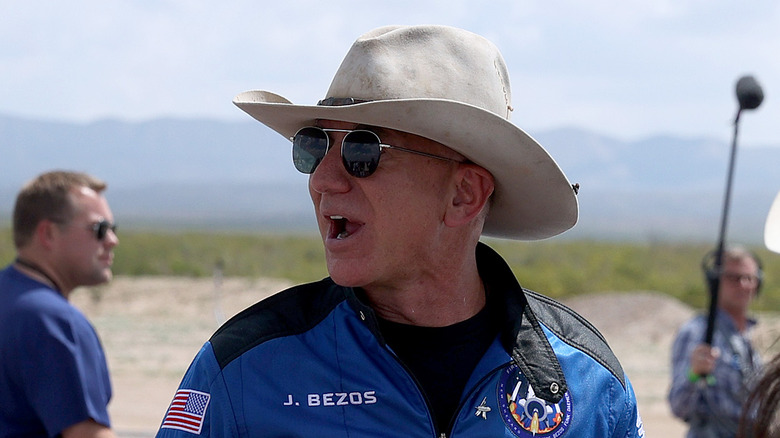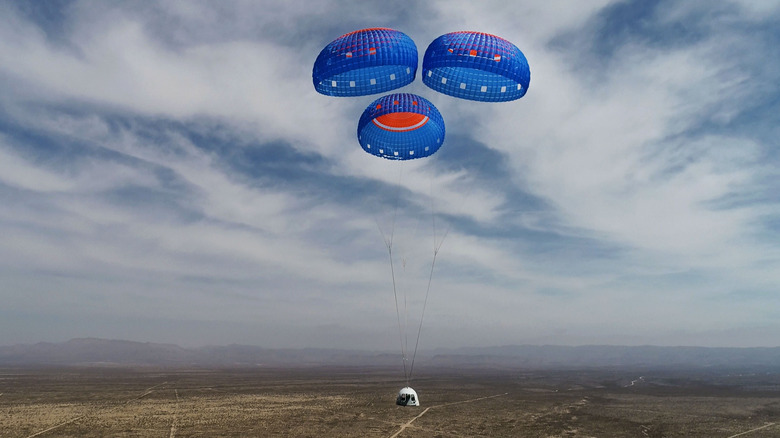Jeff Bezos Explains How To Escape A Rocket That Goes Wrong
Jeff Bezos, after creating and turning Amazon into the world's largest e-commerce giant, is now leading private space tech company Blue Origin with goals of taking humans to the moon and beyond. The former Amazon CEO recently sat with podcast host Lex Fridman and talked about a wide range of topics, from his childhood and business principles to the future of humanity. Bezos also went into detail about Blue Origin's rocket endeavors, space tourism, deals with NASA for lunar missions, and the company's escape system for its space joyride vehicles.
Blue Origin officially classifies it as a full-envelope escape system that is capable of a controlled vertical landing. The company says it can quickly help the crew escape to safety if any hazard alerts are raised. "We have a solid rocket motor in the base of the crew capsule so that if anything goes wrong on [the] ascent, while the main rocket engine is firing, we can ignite this solid rocket motor in the base of the crew capsule and escape from the booster."
The company has been testing the escape system since 2012, and as of 2016, it has conducted five tests in total, of which three were simulated escape tests. Notably, it can be triggered at any stage of the flight, an aspect that has been validated with tests at the mid-flight, launch pad, and in-space scenarios. "The escape system is completely automated," notes Bezos. He argued that automation is optimum because it can jump into action faster.
How does Blue Origin's escape system work?
Inspired by safety protocols put in place for NASA's Apollo and Discovery programs, the system is capable of rapidly separating the crew compartment from the main body of the spacecraft when critical problems are spotted. "It's a very challenging system to build, design, validate, test — all of these things. It is the reason I am comfortable letting anyone go on New Shepard," Jeff Bezos explained.
He added that Blue Origin designed the booster "as safe and reliable as we can make it," but it's not perfect. Just over a year ago, an uncrewed New Shepard rocket experienced a malfunction that caused the booster to crash. Notably, the dozens of scientific experiments it was carrying returned safely when the emergency escape system triggered in time. It was later revealed that a nozzle in the main engine experienced a structural failure due to unprecedented thermal stress.
The Crew Capsule escape system worked "as designed," Blue Origin said in its official statement. The mishap was quite significant, and it was only mid-way through December 2023 that Blue Origin announced plans to resume commercial space flights after a long spell of investigations and engineering work. But Bezos maintains utmost trust in the safety of Blue Origin missions, and especially the reliability of its emergency escape system."If I am not ready to go, then I wouldn't want anyone to go," he said, talking about his trip aboard the New Shepard to the edge of space in 2021.
How Bezos' Blue Origin stands out
Jeff Bezos says the New Shepard has an unusual take on the escape system concept. "Most systems have towers. We have a pusher escape system," he pointed out. It's reusable when a mission does not need to deploy it and everything goes well. Once the escape pod has detached from the main booster system, it deploys a system of three parachutes and slowly descends to safety.
The launch escape system (LES) developed for the Apollo missions would automatically fire at the first sign of a malfunction, jettisoning the command module away from the danger and opening the parachute system to achieve a safe landing. NASA's current-gen Orion spacecraft also features a similar mechanism called the Launch Abort System. SpaceX's Crew Dragon capsule features a system of eight SuperDraco engines reliant on liquid propellants that don't require an external ignition source. In 2020, the Elon Musk-backed company did a successful test of its emergency escape system.
But stepping inside the capsule on its first crewed mission was a gutsy move on Bezos' end. "It's about 10,000 times more dangerous than flying on a commercial airliner," former FAA executive George Nield told Insider about the mission. Mishaps are not rare, though, even in the stomping ground of the most experienced agencies with world-class scientific minds at their disposal. In 2018, cosmonauts Nick Hague and Alexey Ovchinin had to eject their capsule after the booster on their Soyuz rocket experienced issues with stage separation.

